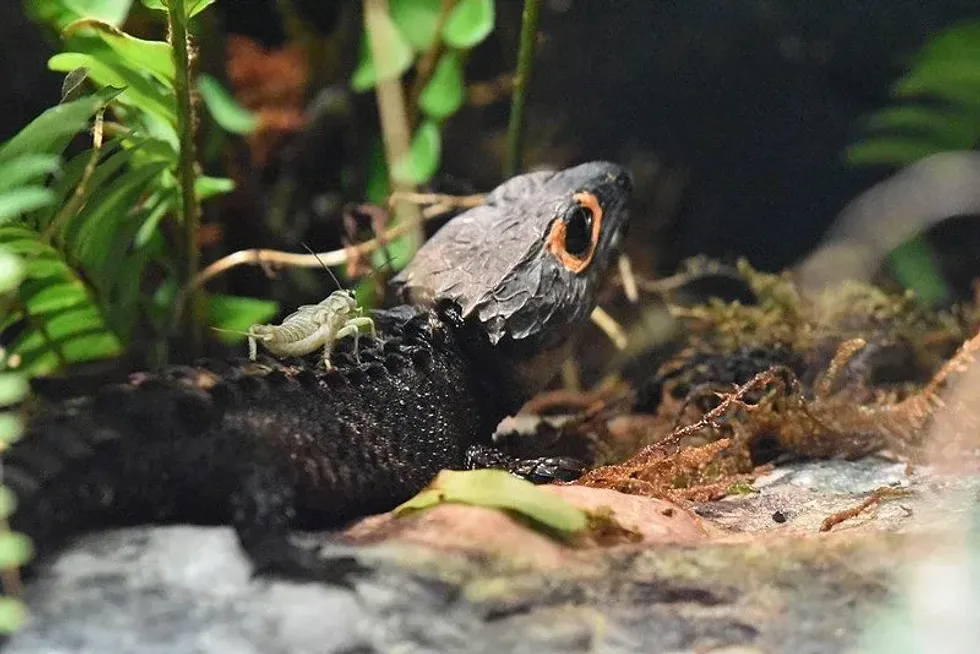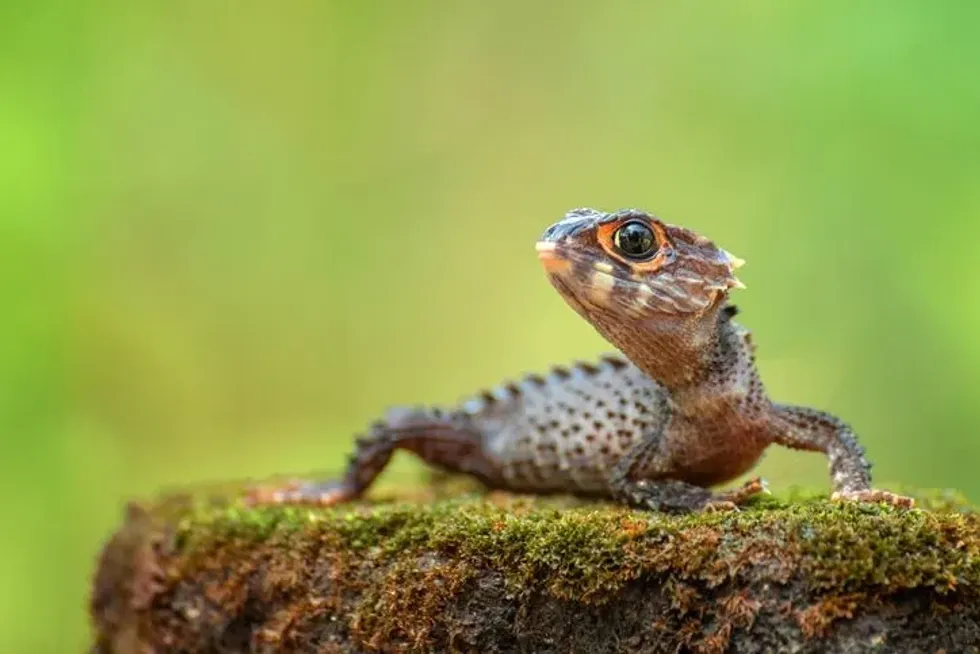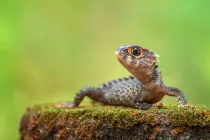Fun Crocodile Skink Facts For Kids

Content
- What type of animal is a Crocodile Skink?
- What class of animal does a Crocodile Skink belong to?
- How many Crocodile Skink are there in the world?
- Where does a Crocodile Skink live?
- What is a Crocodile Skink's habitat?
- Who do Crocodile Skinks live with?
- How long does a Crocodile Skink live?
- How do they reproduce?
- What is their conservation status?
- What do Crocodile Skinks look like?
- How cute are they?
- How do they communicate?
- How big is a Crocodile Skink?
- How fast can a Crocodile Skink run?
- How much does a Crocodile Skink weigh?
- What are their male and female names of the species?
- What would you call a baby Crocodile Skink?
- What do they eat?
- Are they dangerous?
- Would they make a good pet?
- Did you know...
- Are Crocodile Skinks good pets?
- Do Crocodile Skinks lay eggs?
If you come across a reptile with deep brown color, triangular heads, rough scales, bright-orange eye rings, long tails, and four rows of keeled scales resembling a tiny crocodile, don't be mistaken to think of it as a crocodile.
This species is a reptile known as the Red-Eyed Crocodile Skink, scientifically known as Tribolonotus Gracilis, and is a lizard Scincidae family.
They are called Crocodile Skink because of their look.
The white-eyed crocodile skink is also from the Crocodile Skink family; however, the Red-Eyed species are viral. These species are unique reptiles and are native to New Guinea and Indonesia. These lizard-looking reptiles are usually found in the rain forest and hiding under the leaves.
These species are gaining popularity, and everyone wants to have this Skink, Red-Eyed Crocodile as their pet. Below are few facts about the Crocodile Skink that will help you better understand this species. You may also like to look into our other articles on marine toad and bonito fish facts.
Crocodile Skink Interesting Facts
What type of animal is a Crocodile Skink?
The Red-Eyed Crocodile Skink is an uncommon and high humid type of reptile. It is from a genus of lizards are native to New Guinea. These lizards are shy and do not like fighting, and prefer to hide beneath the leaves in their habitat.
They are active in the daytime. They love spending most of their time on the forest floor, although they can only climb low-lying branches. When in distress, it can produce sound.
What class of animal does a Crocodile Skink belong to?
These Crocodile Skinks are lizards from the Animalia kingdom that belongs to the genus Tribolonotus, a part of the family Scincidae.
How many Crocodile Skink are there in the world?
The total population of these Red-Eyed Crocodile Skinks is unknown. As per IUCN red list, these animals are classified as the Least Concern as this species belongs to the Tribolonotus genus of crocodile skinks, which again has eight known species. Currently, there is no threat to this Red-Eyed Crocodile Skink species.
Where does a Crocodile Skink live?
These Red-Eyed Crocodile Skinks reptiles are only found in New Guinea island in Indonesia. The New Guinea habitat has humid bush areas near water, semi-aquatic and dense tropical forests hiding beneath leaves. As a pet, these species are found in the zoo and households.
What is a Crocodile Skink's habitat?
The Red-Eyed Crocodile Skink's preferred habitat is tropical forests. They love to live in a moist and high humidity atmosphere, where the temperature at night is 75-78 °F and day time temperature is 80-82 °F.
Rather than night, they are active in the day. However, these species are great climbers; they love spending time on the forest floor, hiding beneath the leaves from peering eyes during the daytime, and create small nests under the substrate.
Currently, these Red-Eyed Crocodile Skink is living in human habitat as exotic pets. We need to keep some guidelines in mind while considering these reptiles as pets.
It is recommended that you put these reptiles in a terrarium that is 12 in deep and 30 in long with proper ventilation.
To create a natural setup, you can place some coconut fiber, loam soil, and sphagnum and reptile carpet for the substrate and add some small rocks and branches for a natural look giving it a forest look.
A hygrometer can be used to check the humidity levels. If your terrarium is big enough, you can keep two or three Crocodile Skinks together, but they might fight due to their aggressive nature.
Male skinks are aggressive by nature. Therefore, it is better to keep a male and a female in the tank to avoid trouble.
Who do Crocodile Skinks live with?
These exotic species are becoming popular in today's world. These reptiles are also found in the zoo, with pet owners, and one more place where you can find these species is in the pet trade. But the Skinks' preferred habitat is living in the tropical forest with their own kind.
How long does a Crocodile Skink live?
If properly taken care of, this Red-Eyed Crocodile Skink can live an average life of about 6-10 years. If they are taken proper care of and provided with nutritious food in captivity, they can live for several years. The past records state that these reptiles lived for 12 years in captivity.
How do they reproduce?
To attract the female Skink, the males typically battle each other. The male Stink has a gland in its feet to attract the female Skink.
After mating, the female skin gets pregnant and lays eggs. The Crocodile Skink digs a nest before laying the eggs and buries the eggs below the surface.
These Red Eyed Crocodile Skink reptiles are sexually dimorphic, which means both the males and females look different, and it is effortless to identify the sex of these Skinks. Only males have the pores on their hind feet.
At the age of four or five years, the females attain maturity, and males attain maturity at three years. The breeding season mostly begins for Red Eyed Crocodile Skinks is in December until March.
What is their conservation status?
Currently, there are no significant threats to Red-eyed crocodile skinks. As per IUCN survey reports, the Red-Eyed Crocodile Skink is throughout its range, but the exact population count is unknown. As per IUCN, the conservation status is the Least Concern.
Crocodile Skink Fun Facts
What do Crocodile Skinks look like?
The Red-Eyed Crocodile Skinks are small, unique reptiles with a maximum length of four inches. These Crocodile skinks species are a genus of lizards.
These species have a stout body mainly found in gray, and their underbellies are a creamy beige color. They have a head in a triangular or square shape, a long tail, rough scales, orange ringed eyes, and four strong legs.
These animals have four rows of scales that give them a crocodile look. These scales are sharp, protecting them from becoming prey to the other animals.

How cute are they?
They have a great appearance, due to which everyone wants to have one as a pet for themselves. Though these reptiles have a dragon-like appearance, they are docile and sky by nature. Due to their docile nature, these pets are also known as exotic pets.
How do they communicate?
The Skink Crocodile has vocal cords, and they use them when the predators threaten them or when handling this reptile for more than a few minutes. These species make loud sounds like squawks and attempt to escape.
When the predators try to attack them, they will vomit, freeze its body, loosen their tails, and act dead. The predator thinks its prey is dead and will give up.
How big is a Crocodile Skink?
These Red Eyed Crocodile Skink species are small in size, with a maximum length of 4 in, and the average length for an adult Skink can be 8 in. The baby Crocodile Skink can grow from 2.5 inches to a maximum of 10 inches. The male Crocodile Skink is bigger than the female Skink.
How fast can a Crocodile Skink run?
These Red-Eyed Crocodile Skinks are not great runners, but they generally run or freeze themselves when they spot themselves in danger. These reptiles use their tails to escape in water.
How much does a Crocodile Skink weigh?
The Red Eyed Crocodile Skinks average weight is around 1.3-1.6 0z (36-45 g).
What are their male and female names of the species?
There is no specific name for a male or a female Crocodile Skink but identifying the sex of a Crocodile Skinks reptiles is easy; only the males have the pores on their hind feet. At the age of four to five years, the females attain maturity, and males attain maturity at three years.
What would you call a baby Crocodile Skink?
The baby of the Red-Eyed Crocodile Skink is known as a hatchling. The hatchling is light in color, and they have a creamy brown head; they start developing the dark color around the age of six months.
The orange scales are not found around their eyes. These juvenile crocodile skinks become sexually mature at three to four years of age. The juvenile Crocodile Skinks should be fed daily, and when they are grown up, these Skinks should be fed twice a week.
What do they eat?
The Red Eyed Crocodile Skinks are carnivorous and particularly insectivores. These lizards love to eat various insects like fruit flies, silkworms, small crickets, mealworms, and red wiggler worms. Occasionally, you can feed them fish. The baby Skink grows up strong and healthy when fed them various insects that contain calcium and vitamins.
Are they dangerous?
Some humans want to keep this Crocodile Skinks as a pet. How good they are in captivity is unknown as they are rare in captivity. Though they may look dangerous or deadly, these reptiles are shy, harmless, and non-poisonous to humans.
Instead, they are timid and cowardly animals. Sometimes they act dead when the predators chase them.
These lizards might bite if you try holding them for more than a few minutes. They like spending time on the floor surface instead of holding in hand. If any other animal eats this Skink, they might suffer from serious health issues.
Would they make a good pet?
Did you know that there are six kinds of Skinks species: Blue-Tongued Skink, Schneider’s Skink, 'Blue-Tailed' Skink, Red-Eyed Crocodile Skink, Monkey-Tailed Skink, and Fire Skink. All the above species are good pets; however, the Red Eyed Crocodile Skinks are exotic pets found in households and zoos worldwide.
These unique lizards are gaining popularity in the pet trade. They are beautiful lizards which resemble a crocodile are found in captivity. They can live a long life in captivity but required a large terrarium that can bear the high humidity that these species need.
These species make an excellent pet to have. However, proper care and research are necessary.
Did you know...
A few facts about these Crocodile Skink species will amaze you.
These Red-Eyed Crocodile skinks are good actors and can act dead when their predators try to attack them.
The female species have two ovaries, but ovulation only occurs through the right ovary.
These Red-Eyed Crocodile Skinks can stay underwater and hold their breath for a long time.
Its skin has a camouflage quality that protects these species from hiding from their predators.
When the predators grab the tail of these unique Lizards, they have a unique tendency to regenerate the shredded tail within three to four months.
This species will jump into the water and use their powerful tail to escape themselves away from a threat.
Are Crocodile Skinks good pets?
Yes, the Crocodile Skinks are perfect pets for beginners but should not be held in the hands frequently. These Red-Eyed Crocodile Skinks are insectivores. Insect-feeding species are easy to handle.
However, you cannot play with these Skink like other animals. Easy to maintain, they are secretive creatures, and they do not interact or like to be friendly with others because of their shy temperament. These species are gaining popularity because of their appearance.
Do Crocodile Skinks lay eggs?
Male Crocodile Skinks have glands on their feet to attract the female Skink, which is how mating happens. Once they mate, the female Skink becomes pregnant and lays eggs. The female Skink tends to lay only one egg in a week, which continues for five to six weeks. The female Skink may lay 10 eggs per year.
The Crocodile Skink digs a nest before laying the eggs and buries the eggs below the surface. In terms of Crocodile Skink care, the mother is very protective about their eggs, and they wrap around the eggs for days before they hatch.
The baby of the crocodile Skink is called hatchlings. The hatchlings stay with their mother for two weeks, and they form a great bond with their mother.
Before you get this lizard as a pet, you should research their habitat, temperament, food habits, Crocodile Skink care, and health issues. Though this requires patience, it is worth knowing about this species. The breeders sell the baby Crocodile Skink for $188-$279 and it is always to suggested to buy from known and trusted breeders.
Though the average life span of this Crocodile Skink is five to six years, if properly taken care their average lifespan can be up to 12 years in captivity; these species are healthy. Like other animals, they also suffer from some rare diseases like bone disease and respiratory infections due to inadequate calcium.
This can be reduced by providing UV lights or giving high calcium food.
Here at Kidadl, we have carefully created lots of interesting family-friendly animal facts for everyone to discover! Learn more about some other amphibians including pool frog, or caecilian.
You can even occupy yourself at home by drawing one on our Crocodile Skink coloring pages.
We Want Your Photos!
More for You
Bachelor of Science specializing in Computer Science

Christian MbaBachelor of Science specializing in Computer Science
Christian Mba is an experienced blogger and content writer with over a decade of experience. He holds a Bachelor of Science degree in Computer Science from Nigeria and has a keen interest in Python programming. Along with his writing and blogging expertise, he is also an SEO specialist with more than six years of experience. Chris, as he is commonly known, has a passion for music and enjoys playing the piano.
Bachelor of Arts specializing in English Language and Literature, Master of Arts specializing in Philosophy and Religious Studies

Tehil DavidBachelor of Arts specializing in English Language and Literature, Master of Arts specializing in Philosophy and Religious Studies
Tehil David Singh is a fact checker with a Bachelor's degree in English literature from St.Xavier's College, Palayamkottai, and a Master's degree in Philosophy, and Religion from Madurai Kamaraj University. He has a passion for writing and hopes to become a story writer in the future. Tehil has previously interned in content writing and has been a content creator for the last three years. In his personal life, he enjoys singing, songwriting, performing, and writing stories.
Disclaimer
1) Kidadl is independent and to make our service free to you the reader we are supported by advertising. We hope you love our recommendations for products and services! What we suggest is selected independently by the Kidadl team. If you purchase using the Buy Now button we may earn a small commission. This does not influence our choices. Prices are correct and items are available at the time the article was published but we cannot guarantee that on the time of reading. Please note that Kidadl is a participant in the Amazon Services LLC Associates Program, an affiliate advertising program designed to provide a means for sites to earn advertising fees by advertising and linking to Amazon. We also link to other websites, but are not responsible for their content.
2) At Kidadl, we strive to recommend the very best activities and events. We will always aim to give you accurate information at the date of publication - however, information does change, so it’s important you do your own research, double-check and make the decision that is right for your family. We recognise that not all activities and ideas are appropriate for all children and families or in all circumstances. Our recommended activities are based on age but these are a guide. We recommend that these ideas are used as inspiration, that ideas are undertaken with appropriate adult supervision, and that each adult uses their own discretion and knowledge of their children to consider the safety and suitability. Kidadl cannot accept liability for the execution of these ideas, and parental supervision is advised at all times, as safety is paramount. Anyone using the information provided by Kidadl does so at their own risk and we can not accept liability if things go wrong.
3) Because we are an educational resource, we have quotes and facts about a range of historical and modern figures. We do not endorse the actions of or rhetoric of all the people included in these collections, but we think they are important for growing minds to learn about under the guidance of parents or guardians.







